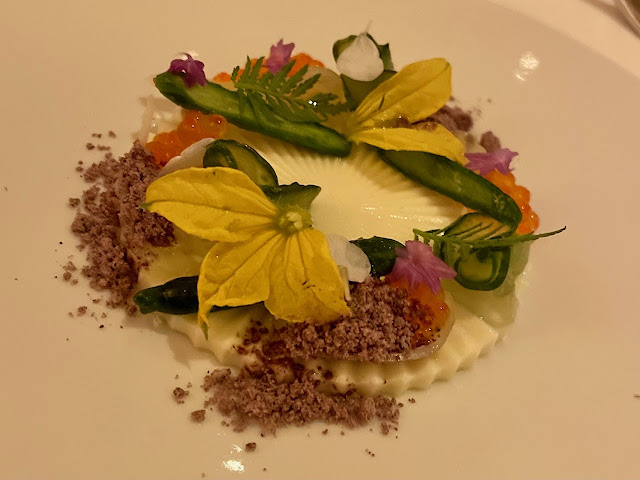 |
| Starting with the house vermouth in The Lounge |
March, Goodnight Hospitality's tasting menu restaurant, is marching into the new season with Greece as their latest culinary inspiration. March is one of my favorite restaurants in Houston for a fine dining experience. Though we do not have Michelin starred restaurants in Texas, this is certainly an establishment that would deserve their top ranking.
 |
| The latest rendition of the March Martini. |
I went on opening night to taste the 9 course Exploration menu with the 9 course Classic drink pairings. The Classic drinks menu features mostly wines from Greece while the pricier Premier menu features wines from around the world. I was more interested in trying the Greek wine selections with this new menu.
 |
| The Lounge Snacks served on a Portuguese Surrealejos tile. |
A friend and I arrived at 5:30 to enjoy some time at The Lounge before beginning our gastronomical adventure. All guests to The Lounge receive a pour of the house Vermouth (which changes seasonally) and a tile with four unique bites to start. We each ordered a cocktail, the March Martini, which comes with a fried olive to start. Anther add-on option that we did not partake of is caviar service. The Greek snack starter tile included Kataifi & Shrimp, Grape & Halloumi, Olive oil & Escargot, and Loukoumas & Foie gras. Our server explained that we would be seeing this theme of Wheat, Grapes, and Olives throughout our meal.
 |
| Course 1 Horiatiki with micro cucumbers and trout roe. |
We were the first guests to be seated in the dining room but the tables were quickly filled. Each course was presented and explained as were each of the wine pairings throughout our Hellenic experience. The first course is called Horiatiki which essentially translates to Greek Salad so the creative license is on display immediately. This dish was served with 2021 Gerovassiliou Malagousia from Macedonia.
 |
| Course 2 Xtapodi |
Next, was Xtapodi or Octopus. While grilled octopus seems to be an ever present menu item these days, this was my favorite presentation that I have ever enjoyed with the octopus very thinly sliced with red grapes, roasted walnut tarator, and beluga lentils. This dish was paired with 2017 Sclavos Robola 'Vino di Sasso' from Cephalonia.
 |
| Course 3 Lavráki |
The bounty from the sea continued with Lavráki: lobster skordalia, preserved lemon, and golden kaluga paired with 2019 Domaine de Kalathas Aspro Potimisi '10+12' from Cyclades. This was another favorite plate of the night.
 |
| Course 4 Spanakopita |
Next up was a vegetable course featuring braised spinach, hedgehog mushrooms, and feta billed as Spanakopita, a far cry from the baked frozen version so often passed at cocktail parties. This course was served with 2020 Skouras Agiorgitiko 'Saint George' from Nemea. This is one of the few Greek grape varieties that I am familiar with, it is often compared to Cabernet Sauvignon.
 |
| Kevin explaining the Course 5 - Opson Kai Sitos as my friend intently listens. |
The fifth course billed as Opson Kai Sitos was a spread of several different things to mix and match as we saw fit. It included saganaki, salt cod, loukaniko, crab butter, and barley bread. This was paired with a Greek beer, Mythos Lager and a glass of Plomari 1894 Ouzo.
 |
| Course 6 Moussaka |
The sixth course was the Moussaka but nothing like the heavy eggplant and potato casserole that carries the same name. Lamb belly was the star of the plate with charred eggplant and dots of a whipped kefalotyri cheese sauce. This was presented with a French wine, the 2018 Faury Syrah 'Vielles Vignes' from Saint Joseph in the Rhône Valley.
 |
Kevin adding a flourish to Course 7
Course Seven included some premium slices of A5 Wagyu beef with lemon potatoes and nepitella yogurt garnished with a caper leaf. The wine selection for this was 2020 La Tour Melas 'Cyrus One" from Achinos, it is a blend of Agiorgitiko and Cabernet Franc. |
 |
| Course 8 Galatopita |
Course eight brought Galatopita to the table which traditionally is a custard pie. This non-traditional version included toasted rice and pomagranate. A glass of 2019 Donnafugata Zibbibo 'Ben Rye' which is an Italian Passito di Pantellaria accompanied it and Course nine, Giaoúrti, a yogurt topped with kalamata olive oil and lemon balm. I added an espresso to finish my meal.
 |
Course 9 Giaoúrti
|
Course nine was not the end, however, 3 different mignardises, not pictured, arrived to the table for the finale of our meal, each tiny treat inspired by other Greek sweets. This is my fourth visit to March, they opened late March of 2021 and I have looked forward to tasting each change of the menu. The name March signifies the boundary between frontiers or realms where there are layers of cultures and ecosystems. Each new menu explores a different part of the Mediterranean.
 |
| Haley James, part of the Sommelier team, oversaw our beverages on this evening. |
As I stated previously, I consider this to be a top dining experience in Houston that unquestionably rivals some starred Michelin restaurants that I have been fortunate to enjoy in both the U.S and in Europe. It is meant to be a unique gastronomical journey through a Mediterranean region via a decidedly contemporary approach. The service is always impeccable, the wine pairings are spot on, and the meal is indisputably memorable. Highly recommended for enophiles and gourmands looking for an exclusive and uncommon night out in Houston, it is a three out of three stars experience.













Comments
Post a Comment
Thank you for reading Wine Life - Houston.